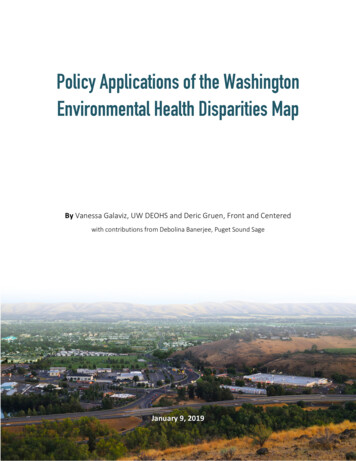
Transcription
Policy Applications of the WashingtonEnvironmental Health Disparities MapBy Vanessa Galaviz, UW DEOHS and Deric Gruen, Front and Centeredwith contributions from Debolina Banerjee, Puget Sound SageJanuary 9, 2019
Table of ContentsKEY POINTS . 2BACKGROUND . 3POLICY IMPLICATIONS . 3APPLICATIONS AND EXAMPLES . 4Designating Disadvantaged Communities . 4Resource & Funding Prioritization . 4Jobs & Hiring Prioritization. 5Enforcement and Inspection Prioritization. 5Land-use Planning & Permitting. 5Public Participation & Local Accountability . 6PRECEDENT IN WASHINGTON . 6CONCLUSION. 7REFERENCES . 7Key Points In Washington, state and local agencies are starting to use environmentalimpacts mapping for investments, policies, and program decisions. The new Washington Environmental Health Disparities Map is a sciencebased tool that combines data on pollution and vulnerability to pollutionto compare the cumulative impacts for Washington communitiesstatewide. The Map has many applications, including designating communities withcumulative impacts, prioritizing resources, hiring, and enforcement; andimproving land use regulation, public participation and accountability, anddata accuracy. States like California have used a similar cumulative impacts map toprioritize billions of dollars in environmental investments and to improvethe effectiveness of their policies.
BackgroundMany communities live near multiple sources of pollution including industrial facilities, hazardous waste sites,and traffic-related pollutants. Communities with multiple sources of pollution are predominantly low-incomeand communities of color and also face increased vulnerability to pollution as a result of factors such asunemployment and low education. A combination of multiple pollution sources and increased vulnerability topollution results in higher cumulative impacts.1A combination of multiple pollution sources and increased vulnerability topollution results in higher cumulative impacts.1The new Washington Environmental Health Disparities Map is made up of 19 indicators of pollution andvulnerability to pollution as developed by a cross-sector collaboration among researchers, government agenciesand community-based organizations. Indicators include race/ethnicity, poverty, toxic releases from facilities,proximity to hazardous waste facilities, lead risk from housing, transportation expense, and low birth rate. EachWashington census tract is given a cumulative impact score, ranging from 0 to 10, based on the 19 indicators.Census tracts with high cumulative impact scores have high pollution and vulnerability to pollution. The mapwas developed to characterize impact from stressors that can affect health and is not a measure of health risk.For more information visit: licy ImplicationsChemical-by-chemical and source-specific assessments of pollution is the traditional approach used to informenvironmental and public health decision making by governmental agencies and policy makers. At present,consideration of cumulative impacts generally occurs at the discretion of the decision-maker. Although theremay be recognition of and desire to incorporate cumulative impacts by decision-makers, this requires analysismethods and tools to be available. The Environmental Health Disparities Map enhances the ability ofgovernmental agencies and policy makers to more systematically factor cumulative impacts into their decisionmaking. The use of a similar tool in California, known as CalEnviroScreen, was developed by the CaliforniaEnvironmental Protection Agency and the Office of Environmental Health Hazard Assessment to identifycommunities with high pollution and vulnerable to pollution. Below we illustrate the benefits of integrating acumulative impact tool into decision-making drawing from various applications and ies toxic-waste-20
Applications and ExamplesAll Washington residents should have the opportunity for good health and tolive in a healthy environment. The Washington Environmental Health Mapcreates the opportunity to inform environmental policy and direct resourcesto the communities facing the greatest cumulative impacts. The achievementof good health and a healthy environment is the result of factors anddecisions taken by businesses, government, civil society and households. TheState of Washington has a critical role in creating laws that govern thosedecisions and in allocating public resources. Some of the areas in whichWashington State plays an active role and could employ this tool for targetedresources include:All Washington residentsshould have theopportunity for goodhealth and to live in ahealthy environment.Designating Disadvantaged CommunitiesAgencies can elect to designate disadvantaged communities, above a certain threshold -- for example toptwenty-five percent-- as areas for concentrated environmental and public health attention and action. Bydesignating census tracts it may be easier for agencies and other actors to direct policy and investments to thoseareas and identify what interventions are taking place, where are the gaps and track progress over time. In California, Assembly Bill (AB) 1550 (Gomez, Statutes of 2016) requires twenty-five percent of theproceeds from the Greenhouse Gas Reduction Fund go to projects that provide a benefit todisadvantaged communities. For the purposes of AB 1550, the California Environmental ProtectionAgency, after a series of public workshop, designated areas representing the twenty-five percent highestscoring census tracts in CalEnviroScreen as “disadvantaged communities”.2 This designation has beenwidely used in policy, including Assembly Bill (AB) 2722 (Burke, Statutes of 2016). AB 2722 awardsmonies to neighborhood-scale projects that will reduce greenhouse gas emissions and provide local,environmental, economic, and health benefits to disadvantaged communities.Resource & Funding PrioritizationThe Washington Environmental Health Disparities Map can be used to ensure that resources are being investedin census tracts with high cumulative impacts. This can be done through specifying designated disadvantagedcommunities to receive a proportion or the entirety of a funding pool or resource, through scaling a resourceinvestment proportional to the risk level, or through other strategies that direct investment. Environmentalbenefits can include energy conservation and renewables, affordable housing near transit, clean and efficienttransportation options, and natural resources that lower pollution. By focusing on the highest scoring censustracts from the Washington Environmental Health Disparities map the state can allocate investments, programs,and other resources to ensure environmental and public health equity. 23In California, as of 2018, fifty-one percent of the 2.0 billion in cap-and-trade auction proceeds, arefunding projects that provide benefits to disadvantaged communities identified by CalEnviroScreen3.This has included 60,000 projects installing efficiency measures in homes, over 330 transit agencyprojects funded, adding or expanding transit options, over 1,600 affordable housing units /2018 cci annual report.pdf
contract, 267 million to collect neighborhood level air pollution from communities most burdened, andbetween 2016-2017 500,000 in community capacity building and technical assistance.Jobs & Hiring PrioritizationThe Washington Environmental Health Disparities Map can also be used to get the most out of every investmentas a reference for hiring criteria. Priority hire or ‘local hire’ is a policy that requires hiring organizations to hirefrom a certain area. While this is most often used to address economic distress, it can also be used to reduceenvironmental health distress by creating jobs and skills for workers in communities with high cumulativeimpacts. The City of Seattle passed a priority hire law in 2015 that sets contract requirements for the percentageof hours worked by residents of economically distressed ZIP codes on public projects through mastercommunity workforce agreements in collaboration with labor unions, contractors and communitypartners. After 13 projects the program has doubled the share of workers from economically distressedareas from twelve percent to twenty-six percent and worked 185 percent more hours on applicableprojects equating to 7 million more in wages.Enforcement and Inspection PrioritizationThe Washington Environmental Health Disparities Map can help inspectors focus their time and efforts not justto those projects with the greatest potential for violations, but also to the areas that may be most impacted bythese violations. Inspectors may also be able to better target their inspections by having information aboutwhich environmental hazards are ranked highest in the area that they are inspecting. As a result of resident concerns for lack of compliance and enforcement actions in their community, theCalifornia Environmental Protection Agency conducted two pilot initiatives to coordinate cross-mediaand multi-agency enforcement of environmental laws intended to protect public health and theenvironment. These pilot initiatives used CalEnviroScreen to identify which communities to prioritizeefforts, including community consultations, inspections, and enforcement coupled with complianceassistance. The success of these two pilot initiatives led to a permanent state wide staffed unit known asthe Environmental Justice Task Force dedicated to ensuring compliance and enforcement indisadvantaged communities identified by CalEnviroScreen4. Currently, there have been four successfulcross-media multi-agency initiatives throughout California state. The most recent initiative inspected150 facilities and 300 heavy-duty trucks over the course of 3 months. Of the 138 violations, 135 madecorrections and were deemed compliant with support from a compliance assistance course.5Land-use Planning & PermittingThe Washington Environmental Health Disparities Map can be used to avoid adding new environmental hazardsto communities that have high cumulative impacts. Planning and permitting agencies can take into account theexisting cumulative impacts to ensure a higher level of assessment when issuing permission for proposedfacilities like incinerators. The tool can also be used for affirmative planning to boost environmental equity, by,for example, using the tool in comprehensive plans, community plans, or land use changes to mitigate riskswhere they’re highest, or, to require planning for environmental justice efforts for jurisdictions that have censustracts with high cumulative ?appid 3c70b0d713b940b9b508e172996da95a
In California, Senate Bill 1000 (Leyva, Statutes of 2016) requires jurisdictions (a city, a county, or a cityand county) that have one or more disadvantaged communities to either adopt a standaloneenvironmental justice element or integrate environmental justice goals, objectives, and policies intoother elements of their General Plans. The bill also includes a process for communities to becomemeaningfully involved in the decision-making processes that govern land use planning in theirneighborhoods.Public Participation & Local AccountabilityThere is solid scientific evidence that community engagement reduces healthdisparities due to factors such as improved knowledge and self-efficiency .Communities burdened with high cumulative impacts are less likely to participate in public processes as a resultof lack of outreach and information dissemination, lack of resources to attend such as child care andtransportation, language barriers, health issues, and time. High cumulative impact communities systematicallysuffer from worse health outcomes than communities with low cumulative impacts resulting in healthdisparities. There is solid scientific evidence that community engagement reduces health disparities due tofactors such as improved knowledge and self-efficiency. Therefore, another potential use of the WashingtonEnvironmental Health Disparities Map is targeting improved community engagement in census tracts with highcumulative impacts to improve public health. Additional benefits from increased community engagementinclude reciprocal knowledge translation, improved community-stakeholder relationships, and improvements inthe Washington Environmental Health Disparities Map as new concerns are identified and data sources aredeveloped to respond to those concerns. In California, disadvantaged communities, as designated by CalEnviroScreen, use CalEnviroScreen toidentify environmental and public health initiatives. For example, a community organization reached outto the California Environmental Protection Agency to collaborate on collecting water quality data toimprove the CalEnviroScreen data for their community.6In 2017, California had over 350 outreach events to better connect disadvantaged communities withfunding opportunities.7 As a result, community engagement efforts have risen 75 percent from 2016.Precedent in WashingtonThere are efforts underway to use cumulative impacts assessment in Washington State, although they arerelatively new and not as widely adopted. The Washington Environmental Health Disparities Map can be used asa source of comparison and complement existing cumulative impact tools.At the state level, the Washington Tracking Network Information by Location (IBL) Tool, which hosts theEnvironmental Health Disparities Map, has several indexes that provide a cumulative rank of health and socioeconomics factors. The Washington State Department of Ecology (Ecology) is using the IBL tool in variousdecision-making processes. For example, IBL is being used to assist in awarding Volkswagen settlement funds.Over 20 million in settlement funds were recently awarded to school districts and public transit fleets to buyelectric or low-emission ctionproceeds/2018 cci annual report.pdf
The Washington Department of Natural Resources developed an index of cities in Washington state to triageareas that had higher populations with lower incomes and ethnic diversity and that were below national averagefor tree canopy, rapidly urbanizing, and had known storm water management issues. The index is used toprioritize resources in the Urban and Community Forestry Program, including local grants.At the local level, King County has various mapping projects that collect local data for place-based, health,environment and equity outcomes. One mapping project is known as the King County’s Climate & Equity StoryMap which is a tool under development that measures projected climate impacts with socioeconomic equitylayers to communicate disproportionate impacts and vulnerabilities of climate change. Another mapping projectincludes the King County Communities of Opportunity interactive data sets that help track measures of health,housing, economic opportunity and community connections to calculate quality of life and social well-being ofresidents.8 Lastly, the King County Land Conservation Initiative Story Map measures access and availability ofopen space across King County and will be used to invest 160 million in communities that lack public openspace. 9 The City of Tacoma has developed a mapping tool called the Tacoma Equity Index that layers social,economic, and environmental elements, like tree canopy and open space to create a score for each blockgroup.10 They have just completed the development phase and are exploring the best applications.ConclusionUnderstanding the cumulative impacts from the complex interaction between pollution and vulnerability canallow for informed decision-making to improve public health and the environment. The WashingtonEnvironmental Health Disparities Map is a science-based tool that allows for cumulative impact comparisonbetween census tracts and allows diverse agencies, policymakers, and community based organizations to makeinformed decisions. For more information current state policy opportunities that are accounting for cumulativeimpacts contact Front and Centered //www.ucc.org/environmental-ministries nproceeds/2018 cci annual ?appid ca.gov/cc/capandtrade/auctionproceeds/2018 cci annual w.arcgis.com/home/webmap/viewer.html?webmap vation/StoryMap.aspx10 ap 4b7b855cff224df89c3f6633f1faa859&extent89
In Washington, state and local agencies are starting to use environmental impacts mapping for investments, policies, and program decisions. The new Washington Environmental Health Disparities Map is a science-based tool that combines data on pollution and vulnerability to pollution to compare the cumulative impacts for Washington communities










